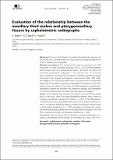Bu öğeden alıntı yapmak, öğeye bağlanmak için bu tanımlayıcıyı kullanınız:
http://hdl.handle.net/11547/11380| Başlık: | Evaluation of the relationship between the maxillary third molars and pterygomaxillary fissure by cephalometric radiographs |
| Yazarlar: | Sadry, S |
| Anahtar kelimeler: | TOMOGRAPHY PREVALENCE |
| Yayın Tarihi: | 2021 |
| Seri/Rapor No:: | 80;2 |
| Özet: | Background: The aim of this study is to evaluate the relationship between the third molars which are determined to be closely related to pterygomaxillary fissure (PTM) in cephalometric radiographs. Materials and methods: The material of this study was panoramic from 200 individuals (101 male, 99 female, mean age 19.02 +/- 1.62) with three different skeletal malocclusion in the sagittal direction (class I: 109; class II: 66; class III: 25) and lateral cephalometric radiographs. It was observed that 151 of the patients included in this study had unilateral, 49 bilateral impacted maxillary third molars teeth. Angular and millimetric measurements (SNA degrees, SNB degrees, ANB degrees, PTM [Height-x], PTM [Width-y]) were made in accordance with the parameters determined on the lateral cephalometric radiographs of individuals. In this retrospective study, the relation of impaction with PTM evaluated on cephalometric radiographs, whether the impaction was unilateral or bilateral, was investigated in terms of skeletal anomaly. Chi-square test was used for the analysis. Results: Of the 200 individuals with impacted maxillary third molar, 99 were female and 101 were male. There is no statistical difference between them in terms of unilateral and bilateral impacted third molars (p > 0.05). Of the 200 patients, 109 patients were class I, 66 patients were class II, and 25 patients were class III. There is no statistical difference between unilateral and bilateral impacted cases in facial skeletal classification (p > 0.05). According to chi-square test results, the relationship between genders and PTM variable width and height (PTM-x and PTM-y) measurements were not statistically significant (p > 0.05). Conclusions: The fact that the third molar teeth are impacted bilaterally or unilaterally is not affected by PTM change. |
| URI: | http://hdl.handle.net/11547/11380 |
| ISSN: | 0015-5659 1644-3284 |
| Koleksiyonlarda Görünür: | Web Of Science |
Bu öğenin dosyaları:
| Dosya | Açıklama | Boyut | Biçim | |
|---|---|---|---|---|
| 69473-221089-2-PB.pdf | 298.9 kB | Adobe PDF |  Göster/Aç |
DSpace'deki bütün öğeler, aksi belirtilmedikçe, tüm hakları saklı tutulmak şartıyla telif hakkı ile korunmaktadır.
